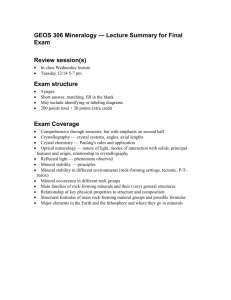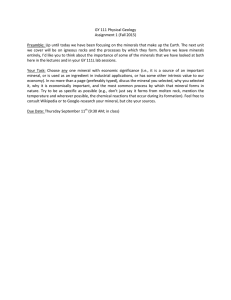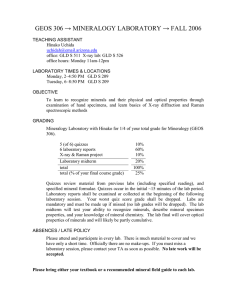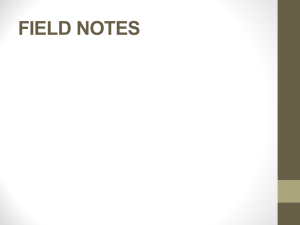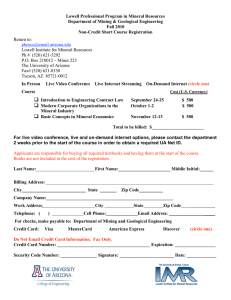Environmental Mineralogy (GEOL 40095/50095/60096-006) – Fall 2012 Syllabus Instructor:
advertisement
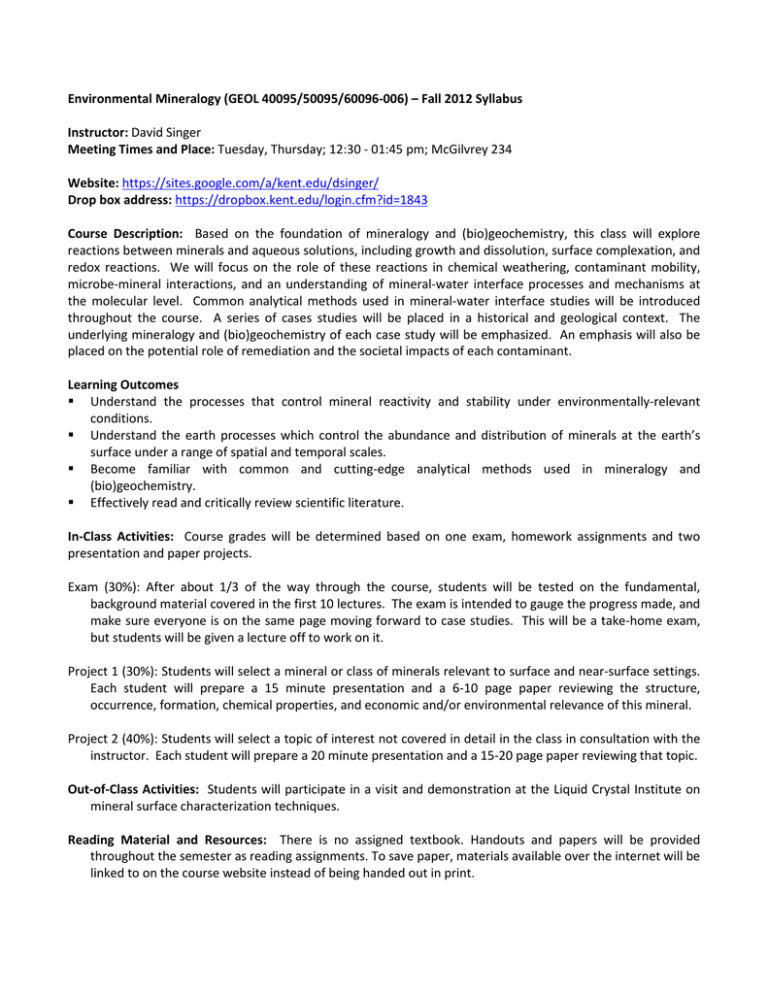
Environmental Mineralogy (GEOL 40095/50095/60096-006) – Fall 2012 Syllabus Instructor: David Singer Meeting Times and Place: Tuesday, Thursday; 12:30 - 01:45 pm; McGilvrey 234 Website: https://sites.google.com/a/kent.edu/dsinger/ Drop box address: https://dropbox.kent.edu/login.cfm?id=1843 Course Description: Based on the foundation of mineralogy and (bio)geochemistry, this class will explore reactions between minerals and aqueous solutions, including growth and dissolution, surface complexation, and redox reactions. We will focus on the role of these reactions in chemical weathering, contaminant mobility, microbe-mineral interactions, and an understanding of mineral-water interface processes and mechanisms at the molecular level. Common analytical methods used in mineral-water interface studies will be introduced throughout the course. A series of cases studies will be placed in a historical and geological context. The underlying mineralogy and (bio)geochemistry of each case study will be emphasized. An emphasis will also be placed on the potential role of remediation and the societal impacts of each contaminant. Learning Outcomes Understand the processes that control mineral reactivity and stability under environmentally-relevant conditions. Understand the earth processes which control the abundance and distribution of minerals at the earth’s surface under a range of spatial and temporal scales. Become familiar with common and cutting-edge analytical methods used in mineralogy and (bio)geochemistry. Effectively read and critically review scientific literature. In-Class Activities: Course grades will be determined based on one exam, homework assignments and two presentation and paper projects. Exam (30%): After about 1/3 of the way through the course, students will be tested on the fundamental, background material covered in the first 10 lectures. The exam is intended to gauge the progress made, and make sure everyone is on the same page moving forward to case studies. This will be a take-home exam, but students will be given a lecture off to work on it. Project 1 (30%): Students will select a mineral or class of minerals relevant to surface and near-surface settings. Each student will prepare a 15 minute presentation and a 6-10 page paper reviewing the structure, occurrence, formation, chemical properties, and economic and/or environmental relevance of this mineral. Project 2 (40%): Students will select a topic of interest not covered in detail in the class in consultation with the instructor. Each student will prepare a 20 minute presentation and a 15-20 page paper reviewing that topic. Out-of-Class Activities: Students will participate in a visit and demonstration at the Liquid Crystal Institute on mineral surface characterization techniques. Reading Material and Resources: There is no assigned textbook. Handouts and papers will be provided throughout the semester as reading assignments. To save paper, materials available over the internet will be linked to on the course website instead of being handed out in print. Course Schedule: Date Class # 8/28 1 Topic Introduction; course overview; environmental mineralogy and historical overview; course goals. Mineral evolution and Earth History 8/30 2 9/4 3 Introduction to Mineral Surfaces and brief overview of techniques 9/6 4 Mineral surface composition and structure (method: AFM, surface x-ray scattering) 9/11 5 Surface Charging and the Electrical Double Layer and Surface Complexation Modeling (Methods: Zeta Potential and BET Surface Area Measurements) 9/13 6 Ion Adsorption: Inorganic sorbents. (Methods: X-ray Absorption Spectroscopy) *** meet on Wed. 9/19? 9/20 7 Ion Adsorption: Organic sorbents 8 9/25 9 9/27 10 Mineral Nucleation and Growth; Methods: Atomic Force Microscopy (AFM) and Scanning Tunneling Microscopy (STM) Mineral Surface Redox Reactions; Dissolution of Oxides and Sulfides. (Methods: X-ray Photoelectron Spectroscopy (XPS) and Auger Electron Spectroscopy (AES)) Nanominerals I: Occurrence, importance, and environmental impact *** meet on Wed. 10/3? 10/4 11 *** meet on Wed. 10/10? 10/11 13 12 14 Nanominerals II: Formation, Stability, and Reactivity; Method: Small Angle X-ray Scattering (SAXS), PDF Analysis of X-ray Scattering Data Microbe-Mineral Interactions: Ion Adsorption, Biofilms, Bacterial-Promoted Mineral Dissolution, Microbial Biomineralization; Methods: X-ray Standing Waves (XSW) No class – EXAM will be posted on-line for students on Sunday October 7th, and due by 4pm on October 10th. Mineral resources I: from mines to production Reading Assignment – Homework Assignments Hazen et al. 2008 Hazen et al. 2009 Hazen et al. 2012 Maurice (ch. 4 and 5) Calas and Hawthorne (1988) Luttge and Arvidson (2008) Eng et al. (2000) Fenter et al. (2000a) Petitto et al. (2010) Maurice (ch. 6) Waite et al. (1994) Fenter et al. (2000b) Fenter et al. (2000c) Maurice (ch. 7) Fendorf et al (1997) Catalano et al. (2008) Fenter et al. (2008) Maurice (ch. 8) Myneni (2002) Maurice (ch. 9) Benning and Waychunas (2008) Maurice (ch. 10) Hochella (1988) Maurice (ch. 13) Banfield and Zhang (2001) Project #1 assigned Waychunas (2001) Gilbert et al. (2004) Templeton and Knowles (2009) Weiner and Dove (2003) Lowenstern et al. (1991) (x-ray microprobe analysis) Strawn et al. (2002) Vaughan et al. (2002) Mineral resources II: Mine wastes: composition, changes Jamieson (2011) during processing, env. Impact Nuclear Fuel Cycle: ore minerals and nuclear waste forms Ewing (2006) Grambow (2006) Lumpkin (2006) Macfarlane and Miller (2007) Class Project I: Student Presentations I Project #1 due for all students Class Project I: Student Presentations II Radioactive Contaminants: U, Pu, Cs, Sr Clark et al (2006) Zachara et al. (2007) Grambow and Poinssot (2012) Toxic Metals Case Study I: Arsenic O’Day (2006) Morin and Calas (2006) Polizzotto et al. (2008) 10/16 15 10/18 16 10/23 10/25 10/30 17 18 19 11/1 20 11/6 21 Toxic Metals Case Study III: Chromium 11/8 22 Toxic Metals Case Study IV: Mercury 11/13 11/15 23 24 FIELD/LAB trip – AFM/SEM (tbd) Other Metals: Silver, Gold, Pt-group 11/20 25 Rare Earth Elements: ore mineral deposits and technological uses 11/27 26 Phosphates and Global Sustainability 11/29 27 Mineral weathering and soil development, The Critical Zone 12/4 12/6 28 29 Class Project II: Student Presentations I Class Project II: Student Presentations II Project #2 assigned Fendorf (1995) Peterson et al (1996) White and Peterson (1996) Zachara et al. (2004) Kim et al (2000) Kim et al (2003 Rytuba (2003) Mungall and Naldrett (2008) Rauch and Morrison (2008) Williams-Jones et al (2009) Walshe and Cleverly (2009) Tosdal et al (2009) Southam et al (2009) Ronnback et al. (2008) Ohta et al. (2009a) Ohta et al. (2009b) DOE report (2010) Filippelli (2002) Oelkers (2008) Filippelli (2008) Manning (2008) Brantley et al. (2007) Anderson et al (2007) Chorover et al (2007) McBride (ch. 9) Project #2 due for all students The instructor reserves the right to modify this syllabus during the semester. These changes will be announced in class, and it is the students’ responsibility to attend class or make other necessary arrangements to be aware of the situation. Grading Policy: The following will yield letter grades: 100-93 A; 92-90 A-; 89-87 B+; 86-83 B; 82-80 B-; 79-77 C+; 76-73 C; 72-70 C- Official dates: University policy requires all students to be officially registered in each class they are attending. Students who are not officially registered for a course by published deadlines should not be attending classes and will not receive credit or a grade for the course. Each student must confirm enrollment by checking his/her class schedule (using Student Tools in FlashLine) prior to the deadline indicated. Registration errors must be corrected prior to the deadline. The schedule adjustment period for students to add full-term courses ends Sunday, Sept. 9. Students are able to withdraw from any or all full-term courses through Sunday, Nov. 4. Statement concerning cheating and plagiarism: University policy 3342-3-01.8 deals with the problem of academic dishonesty, cheating, and plagiarism. None of these will be tolerated in this class. The sanctions provided in this policy will be used to deal with any violations. If you have any questions, please read the policy at http://www.kent.edu/policyreg/chap3/3-01-8.cfm and/or ask. Statement regarding students with disabilities: University policy 3342-3-01.3 requires that students with disabilities be provided reasonable accommodations to ensure their equal access to course content. If you have a documented disability and require accommodations, please contact the instructor at the beginning of the semester to make arrangements for necessary classroom adjustments. Please note, you must first verify your eligibility for these through Student Accessibility Services (contact 330-672-3391 or visit www.kent.edu/sas for more information on registration procedures). Please initial below that you have read these statements: 1. ____________ 2. ____________ 3. ____________ 4. ____________ 5. ____________ 6. ____________ 7. ____________ 8. ____________ 9. ____________ 10.____________
